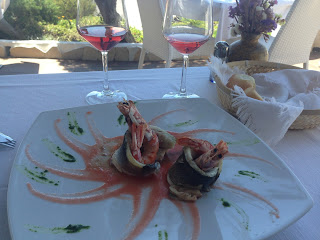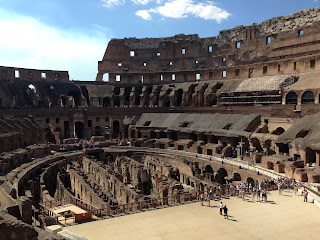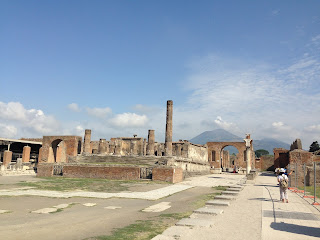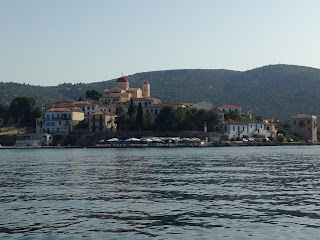
First stop - Ischia - a volcanic island in the northern end of the Gulf of Naples - just a 25 mile sail away. It felt good to be underway on the water. Sadly, we didn't sample the thermal spas the island is known for. In fact, we didn't get ashore at all but not for not trying! There was not a good place to tie up Joy - the one place we did try turned out to be a swimmming spot for the local youth and teh boys thought Joy made a great leg up onto the wharf. Kim enjoyed a little sight from home when Manitou - JFK's old yacht from Newport, RI, anchored near us.
Off we went in the morning, sailing toward Sardinia. The wind was light and variable again, unfortunately, and we motor sailed over much of the 200 mile overnight passage. There was a nice sailing breeze for the last 25 miles or so though and we found a lovely anchorage, Porto Della Taverna, on the northeast side of the island, at the end of the journey.
 The beauty of Sardinia's coast immediately began to sink in. We spent the next week poking around the north coast and down the west - definately in teh playground of teh wealthy now - we were often surrounded by luxury motor yachts. We made a pass through the harbour of Cervo to have a look but no need to deal with that craziness.
The beauty of Sardinia's coast immediately began to sink in. We spent the next week poking around the north coast and down the west - definately in teh playground of teh wealthy now - we were often surrounded by luxury motor yachts. We made a pass through the harbour of Cervo to have a look but no need to deal with that craziness.Moving onward, we marveled at the fantastic rocky cliff formations full of interesting textures and colours. With each one night stop we enjoyed a new view of the island. In Golfo Saline the entertainment was watching the small boats, including lasers and hobie cats, in the sailing school deal with the gusty winds. Capsize!! Brought back lots of memories...

The next day we dealt with that strong wind ourselves as we motored around the corner to Cape Testa - a lovely spot. Here we went ashore for a walk among the huge smooth, sculpted rocks and stopped for a fancy lunch of local fish at Ristorante S'Andira.

Soon it was time to stage for an early morning departure to the Balearic Islands so we scooted around to the inside of the hook of the west side of the cape for the night. We anchored in shallow water by the beach and listened to the music from the party boats...
So that's the news from EQ where the winds are fair, the seas calm, and the crew content.
With Equanimity and Joy


































